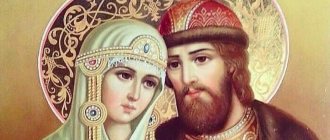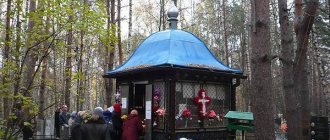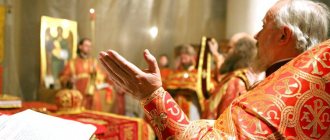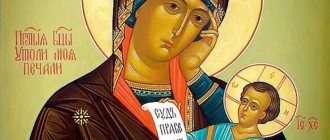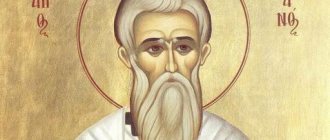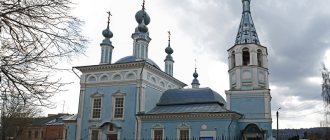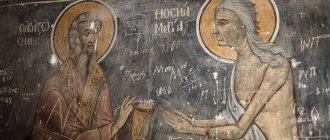"Save me, God!".
Thank you for visiting our website, before you start studying the information, please subscribe to our Orthodox community on Instagram, Lord, Save and Preserve † - https://www.instagram.com/spasi.gospodi/. The community has more than 60,000 subscribers. There are many of us like-minded people and we are growing quickly, we post prayers, sayings of saints, prayer requests, and timely post useful information about holidays and Orthodox events... Subscribe. Guardian Angel to you!
One guard Aglaius and thirty-nine Orthodox warriors martyred on a lake near the Armenian town of Sevas (Sebastius) are the personification of spiritual fortitude, strong faith, and also a model of masculinity. In the same article you can learn about the lives of the Saints, when is the day of the Forty Martyrs of Sebaste, how to pray to them, what they help with and much more.
The Story of the Forty Martyrs of Sebaste
In the 14th century, when the Romans allowed Christians to practice their faith, Emperor Licinius decided to return paganism and resume persecution of the followers of Christ. At first, Licinius planned to cleanse the army of Christians. Forty warriors, true believers in the Lord God, refused to sacrifice to the pagan gods, as demanded by the treacherous emperor and their military leader. They were imprisoned, where they fervently prayed to God, trusting in his will, and several times refused to change their faith.
The future martyrs were tested by cold, forced to enter icy water naked during the frost, but the Christian soldiers passed this test with dignity, only one of them could not stand it and ran to the warmth. In the morning, the guard, amazed by the halos that appeared above the heads of Christians, also decided to accept the faith of Christ and, together with the others, was brutally executed: the believers had their legs broken and burned at the stake.
Veneration in Orthodoxy
The Orthodox Church brings glory, honor and worship to the 40 Martyrs of Sebaste. They are honored in prayers:
- for unshakable faith in the Lord God, self-sacrifice;
- fortitude, piety, patience and willpower;
- for humility, overcoming vices, passions and temptations;
- spiritual purity, love for Jesus and his teaching.
There is an ancient artifact written in ancient Greek. It contains the testament of the Holy Martyrs of Sebaste. In the first part of the historical document, the saints bid farewell to their relatives; in the second, they ask to bury them together, in one grave; in the third, they give spiritual instruction to all Christians. This part is especially important for believers, since those who died for Christ call followers to firmness in faith in the One God, to renounce deception and sensuality, and to strive for eternal life.
They honor the memory of those who died for Christ on March 9 (March 22). The restrictions of Lent are being eased for the celebration. During the evening service, the rite of Communion with the Holy Gifts is performed, which are consecrated at the liturgy preceding this event.
Since ancient times, there has been a touching ritual in Christian families. All relatives make forty Lenten buns in the form of larks with raisin eyes in memory of the ascended holy martyrs.
How do prayers to the 40 Martyrs of Sebaste help?
Dying from cruel tortures and trials, 40 courageous Sebastian warriors did not allow a single thought to renounce their faith. Therefore, praying in front of their holy images and reading a prayer to the 40 saints, believers ask them for help in showing perseverance and determination.
Prayer also helps in times of despair, when a person seems to no longer have the strength to resist misfortune, since the example of the martyrs proves that even the most unbearable torment can be endured thanks to faith and prayers.
Prayer especially helps in strengthening faith, and also helps in finding a job, and in some cases, solving financial problems.
We recommend reading: Icon of the 40 Martyrs of Sebaste
Icon of the Martyrs of Sebaste: what can you ask for?
Most often, Orthodox believers bow before this miraculous image, calling for help in various situations, namely:
- When you need to gain resilience;
- Gain the ability to overcome with dignity all the troubles that arise along a person’s life path;
- Prayer to the Sebastian martyrs can also help preserve or even restore lost faith;
- Unable to overcome despair;
- Lack of strength to deal with the troubles that have arisen and the difficult trials life presents;
- The icon of the Forty Martyrs of Sebaste will help you cope with the lack of mental fortitude and conviction that you are right.
When is the day of celebration of the miraculous image?
Memorial Day in honor of the forty sufferers is one of the most glorified holidays, which in the Christian Orthodox religion is celebrated on March 22 (March 9 - old style). It is worth noting that the holiday itself is not transferable, i.e. its date is fixed and at the same time the severity of Great Lent is eased, and the hymn of the Presanctified Gifts is also performed.
But there are also interesting features of this holiday. On March 21, the day of the Forty Martyrs of Sebaste falls on the vernal equinox, considered the beginning of spring, and therefore there is an interesting custom of preparing ritual cookies in the shape of a bird - “Lark”.
Prayer to the 40 Martyrs of Sebaste
Oh, the holy and glorious passion-bearers of Christ, the fourty, in the city of Sebastia, for the sake of Christ, who courageously suffered through fire and water and, like friends of Christ, entered into the rest of the Heavenly Kingdom, have great boldness to intercede with the Most Holy Trinity for the Christian race, especially for those who worship your holy memory and those who call upon you with faith and love. Ask the All-Bountiful God for forgiveness of our sins and correction of our lives, so that in repentance and unfeigned love for each other, having lived with each other, we will boldly appear before the Last Judgment Seat of Christ and through your intercession we will appear at the right hand of the Righteous Judge.
To her, saints of God, be our protectors from all enemies, visible and invisible, so that under the shelter of your holy prayers we will get rid of all troubles, evils and misfortunes until the last day of our life and thus glorify the Great and Worshipful Name of the Almighty Trinity, Father, Son and Holy Spirit, now and ever and unto ages of ages. Amen.
The History and Power of Prayer
In moments of turmoil and despair, Christian believers turn to the Almighty, asking for His grace, venerating the holy saints, asking for protection and patronage. Among the many iconographic versions, according to church ministers, the icon of the “Forty Martyrs of Sebaste” has special power.
Faced with troubles and various difficulties on the path of life, Orthodox Christians read a prayer to the 40 martyrs of Sebaste. In front of this shrine you can ask:
- regain lost faith in the Almighty;
- restore peace of mind, peace and tranquility;
- heal the soul and body from various ailments;
- drive away confusion, confusion, despair and a feeling of hopelessness;
- to grant the ability and strength to overcome with dignity all the difficulties and troubles that arise along the path of life;
- learn to defend your point of view and gain the ability to cope with a lack of mental fortitude.
Memorial Day in honor of the forty sufferers falls on March 22 (according to the old calendar - March 9). In the Orthodox religion, this holiday is considered non-transitionable. On Memorial Day, the severity of Lent is lightened and the Liturgy of the Pre-Illuminated Gifts is chanted.
You can read the prayer to the 40 Martyrs of Sebaste both in church during a service and at home. According to clergy and Christians who believe in higher powers, prayer will be heard only when it comes from the heart. You can make various requests and pleas to God, the Most Holy Theotokos and the holy great martyrs during morning or evening prayer, in solitude and detached from worldly affairs, driving out anger, hatred and despair from your heart, throwing sinful thoughts and desires out of your head.
The Forty Martyrs of Sebaste represent an example of courage, fortitude and strength of faith.
In 320, during the reign of the Roman emperor Licinius, thirty-nine Christian soldiers and the guard Aglaius suffered martyrdom, not wanting to renounce their faith in Jesus Christ.
Warriors from Cappadocia (the territory of modern Turkey), part of the Roman army, served in the city of Sebastia. The military commander Agricola demanded that the military personnel renounce the Christian faith and make sacrifices to the pagan gods. Christian soldiers refused to carry out this order. For disobedience they were sent to an ice-covered lake. Near the lake, the commander of the Roman army ordered a warm bath to be installed so that those who wished to renounce Jesus Christ and the Christian faith could warm up there.
The warriors stood all night in the icy water. Early in the morning, one of the servicemen could not stand it and ran to the bathhouse. As soon as he crossed the threshold of the bathhouse, he immediately died. None of the warriors of the Christian faith ever wanted to renounce Jesus Christ.
Seeing the fortitude and courage of the Orthodox soldiers, one of the Roman soldiers named Aglaius stepped into the icy lake and joined them. According to legend, members of the Roman army, acting on the orders of the military commander, broke the legs of courageous Christians and burned them at the stake. The charred bones of the martyrs were thrown into the water.
One night, forty martyrs appeared to the Bishop of Sebaste, Blessed Peter, in a dream and were ordered to bury their remains in the earth. The bishop and several clergy collected the remains of the deceased and buried them with honor.
Second prayer
O passion-bearers of Christ, who courageously suffered in the city of Sebaste, we earnestly resort to you as our prayer books and ask: ask the All-Bounteous God for forgiveness of our sins and correction of our lives, so that in repentance and unfeigned love for each other, having lived together, we will boldly present ourselves to the terrible judgment of Christ and through your intercession we will stand at the right hand of the Righteous Judge. To her, God's servants, awaken us, God's servants (names), protectors from all enemies visible and invisible, so that under the shelter of your holy prayers we will get rid of all troubles, evils and misfortunes until the last day of our life, and thus glorify the great and venerable name of the Almighty Trinity, Father and Son and Holy Spirit, now and ever and unto ages of ages. Amen.
What is the Christian feat of the soldiers from Sebastia
At the beginning of the 4th century, by order of St. Constantine the Great, all Christians had the right to worship Christ. However, Licinius, who was preparing an uprising against the emperor. He decided to expel all followers of the new faith from the army.
40 martyrs who suffered in Lake Sebaste
Agricolaus was the military leader of the Sebastian squad, which consisted of 40 Christian warriors who had never known defeat in battle. Licinius demanded that his soldiers constantly make sacrifices and worship idols, but the Armenian heroes refused idolatry.
They were bought with flattery and the promise of high military ranks, they were threatened, they were tortured, but the martyrs survived, and at the cost of their lives they acquired eternity. During the mockery and torture, the Lord constantly demonstrated His protection over the heroes of the faith.
The forty martyrs constantly heard the voice of the Savior, saying that those who believe in Christ, even if they die, will be saved in eternal life, that the crowns of God’s glory are already ready for them.
Blessed Peter, Bishop of Sebaste, saw in a dream 40 martyrs who asked to collect their bones and bury them. Bishop Peter went to the lake on a dark night and saw bones shining like stars, collected them and buried them.
Troparion and Kontakion to the 40 Martyrs of Sebaste
Troparion, tone 1
Through the illnesses of the saints, who suffered for You, beg us, O Lord, and heal all our illnesses, love for mankind, we pray.
Troparion, tone 1
Passion-bearers of all honour, fourty soldiers of Christ, firmaments of arms, for they passed through fire and water, and fellow citizens were quick with the Angel, with them pray to Christ for those who praise you with faith. Glory to Him who gave you strength, glory to Him who crowned you, glory to Him who gives you healing to all.
Troparion, tone 3
The fourty passion-bearers of Christ, who courageously suffered in the city of Sebastia, who passed through fire and water and entered into eternal rest, pray to the Lord for us, that He may preserve our lives in peace and save our souls, as a Lover of mankind.
Folk traditions of celebrating the memory of the Forty Martyrs of Sebaste
The day of remembrance of the 40 Martyrs of Sebaste is popularly called “magpies”, and sometimes “waders”. According to popular belief, on this day forty birds fly from warm countries, and the first of them is the lark. “It happens,” experienced old peasants assure, “that larks arrive earlier, but only those that don’t get there: they will fly and may freeze. And the lark that flies on the magpie is real, it won’t die.” “Magpies” was considered a children’s holiday, because on the eve of the celebration, women baked “larks” from rye flour, and in the morning they distributed them to children. “Larks” were baked with their wings open, as if in flight. The lark either soars up, then “falls” like a stone to the ground - the peasants explained this by the special boldness and humility of these birds before the Lord. The lark quickly rushes upward, but, struck by the greatness of God, it bends down in deep reverence. Thus, the larks depicted the song of glory to the Lord raised by the martyrs, their humility and aspiration upward, to the Kingdom of Heaven, to the Lord Jesus Christ.
Also in the morning, women made forty straw nests in their yard and placed a piece of dough in the shape of an egg in each (this was done so that the chickens would lay eggs at home and not enter someone else's yard). When the dough “larks” were ready, the children ran with them to the barn to cast a spell on the larks. There they sat their birds all together, on a high place, and several times they began to shout a song in chorus: “Larks, fly in, take away the cold winter, bring the warmth of spring: we are tired of winter, we have eaten all our bread.” The lyrics to this children's song varied depending on the region. Then the guys dismantled their larks and ran through the village with the same song. This continued until lunchtime. Having run around enough, the children gathered together and began to eat their rye “larks”. They usually ate the whole bird, leaving the head - each of the children saved it for their mother. At the end of the celebration, the guys congratulated each other on the spring holiday and ran home. At home, each child gave the head of the lark to his mother with the words: “Here, mother, you have a head from the lark: just as the lark flew high, so will your flax be high.” What a head my lark has, so that the flax should be so big-headed.” It was also believed that the weather of spring and summer could be determined based on the weather on Soroca. If it was a frosty morning in Soroka, then expect forty “matinees” in the spring.
